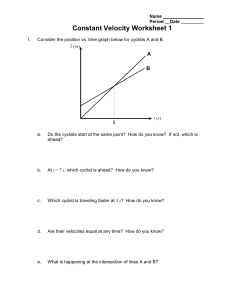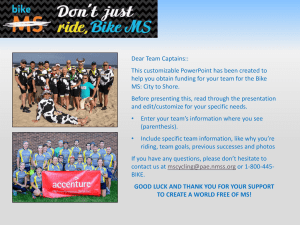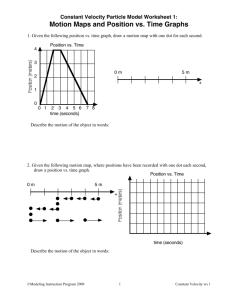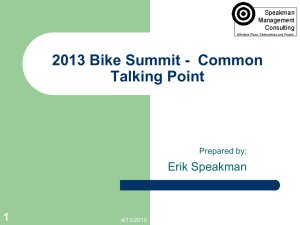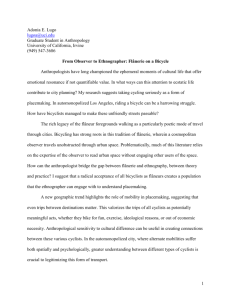BIKE PAL University of Malta, Malta
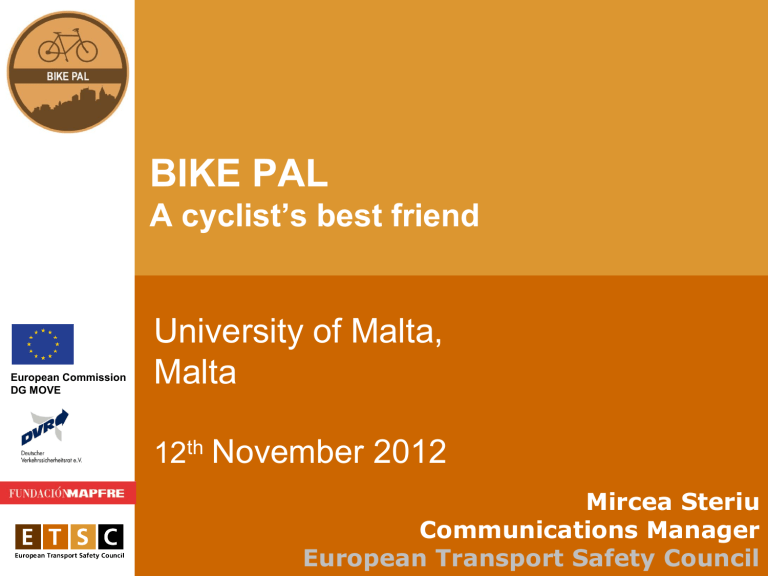
BIKE PAL
A cyclist’s best friend
European Commission
DG MOVE
University of Malta,
Malta
12 th November 2012
Mircea Steriu
Communications Manager
European Transport Safety Council
Introduction to ETSC
Promoting an independent science-based approach to road safety policy
Supported in our work by 46 member organisations across
Europe
Funded by our members, the European Commission, corporate sponsors and Member States
Bringing together practitioners, researchers, policy-makers and parliamentarians from across the whole of the EU www.etsc.eu
ETSC Activities
Monitoring
EU transport safety policy
Safe & Sober
Drink-driving policy network
Road Safety P erformance
Road Safety ‘At’
In dex (PIN) - Ranking EU
Bike Pal
Cycling
Safety
Work
ST udents
A cting to
R educe S peed
EU ambition: road safety/CO2 Targets
EU targets
Cut by 50% yearly road deaths between 2011-
2020
Reduce by 20% green house gas emissions by
2020
State of cyclists’ (un)safety in the EU (1) cyclist deaths non-cyclist deaths
100
90
80
70
60
50
-39%
-43%
40
2001 2002 2003 2004 2005 2006 2007 2008 2009 2010
Relative developments in cyclists’ road deaths and the number of other road deaths in EU countries over the 2001-2010 period.
Cyclist deaths reduced at a lower pace than those for all road users, cyclists facing higher risks
State of cyclists’ (un)safety in the EU (2)
5.00%
0.00%
-5.00%
-10.00%
-15.00%
-20.00%
EU average -5.1%
Average annual percentage change in cyclist deaths over the period 2001-2010
Unfortunately, no data provided from Malta.
Male cyclists involved in more deadly collisions
60%
50%
40%
30%
20%
10%
0%
100%
90%
80%
70% male female
In the EU 78% of the cyclists killed are male.
Elderly have a higher mortality than the rest of the cycling population
27 39
25
20
25-64 EU average 3.9 all ages EU average 4.6
65- EU average 10.6
15
10
5
0
EU: total cycling mortality 4.6
Mortality in 25-64 age group 3.9
Mortality in 65 and over age group 10.6
Cyclists face high risks in urban areas
60%
50%
40%
30%
20%
10%
0%
100%
90%
80%
70% urban non-urban Unknown
In the EU 56% of cyclist deaths are in urban areas.
Cyclists and traffic
60%
50%
40%
30%
20%
10%
0%
100%
90%
80%
70%
Cycle only Car or taxi PTW Goods or public transport vehicle Other vehicle
52% of cyclist deaths follow collisions with cars/taxis
22% after collisions with goods/public transport vehicle
Safety in numbers for cyclists
25.0
20.0
GB
15.0
10.0
5.0
SE†
NO*
DK
NL y = 42.642x
-0.201
R² = 0.4478
0.0
0 100 200 300 400 500 600 700
Km cycled per person-year
800
Correlation between distance cycled and safety...
But people must feel safe to cycle
900 1000
BIKE PAL project
A three-year project which aims to:
• Evaluate the state of play concerning cycling safety;
• Gather good practice in increasing safety levels for this group of vulnerable road users;
• Disseminate knowledge to decision-makers and interested individuals
• Motivate students to take action at local level
• Design, develop and implement local, costeffective safe cycling projects
How to improve cyclists’ safety – good practice from the EU
• Traffic calming, low speed areas, cycling streets
How to improve cyclists’ safety – good practice from the EU
Dedicated cycling infrastructure:
• Contra-flow cycling on one way streets;
• Cycle lanes;
• Cycle tracks;
• Advanced stop lines;
• Safe crossing facilities;
• And many more...
How to improve cyclists’ safety – good practice from the EU
Information and training of cyclists:
• Belgium: “The Great Bicycle
Exam”
• Belgium: Bike Experience
• UK: BIKEABILITY
Information and training of drivers:
• Training on interacting with cyclists on the road
• Enforcement of speed limits
• Enforcement of parking rules
• Improve visibility and reduce blind spots on goods vehicles
How does ‘BIKE PAL’ Work?
1. University lecture tour to recruit students
2. Students apply online to take part in BIKE PAL
3. CAMP: students with the best project ideas attend a one-week training course in Brussels, all costs included
4. Challenge: after returning to their home country in groups of two, students carry a cycling safety activity with the support of ETSC and its partners
5. European Award Ceremony:
Best projects receive award and proper promotion and follow-up is ensured
What should the Students do?
Run a local action to improve the safety of cyclists
Knowledge from the BIKE
PAL camp and support given by ETSC
Best projects need to involve a local authority/ company
Low cost and easy to implement
Why should I Apply?
An opportunity today:
Use your concrete knowledge to solve a serious problem
An opportunity for the future:
BIKE PAL can be a significant gateway for future careers opportunities
An opportunity to learn:
Free training on both technical safety matters and on road safety advocay from international experts
An opportunity to win:
You will receive a substantial award if you do your best in BIKE PAL
To sum-up
Not overly ambitious
English: minimum to interact limited costs
An idea
Free timing
Lobbying local authorities
How can I Apply?
Online: go to www.etsc.eu/bike-pal.php http://www.surveymonkey.com/s/bike_pal
Before 15th December 2012
Mircea.Steriu@etsc.eu
